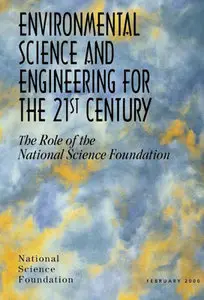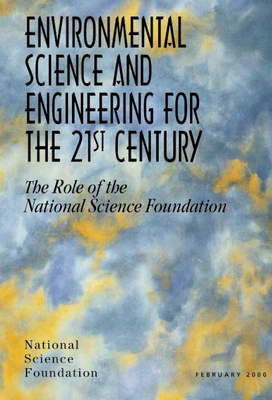Environmental Science and Engineering for the 21st Century: The Role of the National Science Foundation
NSF | 2000 | ISBN: n/a | 127 pages | PDF | 1 MB
NSF | 2000 | ISBN: n/a | 127 pages | PDF | 1 MB
This report presents the findings and recommendations developed by the Task Force on the Environment and approved unanimously by the National Science Board. The report is based on an extensive review of relevant policy documents and reports, a process of hearings and consultations with invested communities, invited commentary from a broad range of organizations and individuals. The task force also examined a wide variety of environmental programs at NSF to determine the factors most likely to result in effective new research and educational activities.
CONTENTS
FOREWORD
ACKNOWLEDGMENTS
EXECUTIVE SUMMARY
CHAPTER 1: INTRODUCTION
The Issues
Old Frameworks and Approaches Are Inadequate
The Necessary Response
Goals for Enhancing the Environmental Portfolio
CHAPTER 2: THE LARGER CONTEXT FOR NSF-SUPPORTED ENVIRONMENTAL RESEARCH, EDUCATION, AND SCIENTIFIC ASSESSMENT
Research Within and Across Agencies
Education and Other Knowledge Transfer
Assessment Roles and Boundaries
Infrastructure in Context
Investments in Environmental Technology
CHAPTER 3: SCOPE OF NSF’S CURRENT ENVIRONMENTAL ACTIVITIES
Research
Education
Scientific Assessment
CHAPTER 4: INPUT RECEIVED ABOUT UNMET NEEDS AND OPPORTUNITIES
General Themes
Input Received During the Hearing Process
Input Received in Response to the Interim Report
CHAPTER 5: FINDINGS AND RECOMMENDATIONS
Keystone Recommendations
Specific Findings and Recommendations
CHAPTER 6: CONCLUSION
REFERENCES
APPENDICES
A: Charge to Task Force on the Environment
B: Literature Compiled and Considered by the Board
C: Sources of Public Comment: Before Release of Interim Report
D: Sources of Public Comment: After Release of Interim Report
E: Letter From the President’s Committee of Advisors on Science and Technology
F: Selected Centers Supported by NSF
G: Acronyms and Abbreviations
BOXES
1. Nature’s Services: What Ecosystems Provide to People, What Is at Risk, and Why New Interdisciplinary Knowledge Is Required
2. Unprecedented Environmental Changes: New Challenges for Humanity
3. Scientific Assessment of Stratospheric Ozone Depletion
4. The Information Explosion and the Technology Revolution
5. Learning Before Doing: New Goals for Environmental Technology
6. Nutrients: Newly Discovered Links Between Agriculture, Energy, Health, Fisheries, Tourism, and Climate
7. Statistical Prevention Models for Wildfire Suppression
8. Complexity Theory and Ecosystems
9. Genomics and Environmental Research
10. Human Dimensions of Environmental Questions
11. Integrated Natural-Socioeconomic Sciences: Some Priorities for Investigation
12. Atmospheric Chemistry
13. New Insight Into Infectious Diseases: An Emerging Interface Between Health and the Environment
TABLES
1. Examples of NSF’s Multi-agency Environmental Activities
2. Examples of Interdisciplinary Special Competitions
3. Recent Scientific Assessments Supported by NSF
4. Programmatic Gaps or Areas Needing Enhancement in the Current NSF Environment
Portfolio Identified by the Board
5. Examples of Technologies With Promise for Environmental Research
FIGURES
1. Human Dominance or Alteration of Major Components of the Earth System
2. NSF Leadership Role
3. Goals and Supporting Elements for NSF’s Environmental Portfolio
with TOC BookMarkLinks



